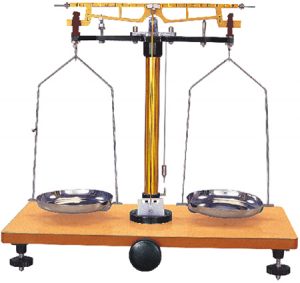Mass and weight
Mass is the quantity of matter in a body, while weight is the Earth’s pull on a body.
Diagram of chemical balance
Source: Google
Note: lever balance and chemical balance are used to measure the mass of an object.
Note: spring balance is used for checking the weight measurement of an object.
Distinction between mass and weight
Weight is seen as a force. Force is the push or pull of an object. Weight has both magnitude and direction and is therefore a vector quantity which is measured in Newtons (N). Mass on the other hand has only magnitude and is therefore a scalar quantity which can be measured in kilograms (kg).
Past questions
- Which of the following statements about mass and weight are correct? (Waec 2015)
- Weight is the force of gravity on a body
- The mass of a body is the quantity of matter in the body
- The weight of a body is greatest at the equator
- The mass of a body is greatest at the poles
A. I and II only
B. I and III only
C. II and IV only
D. III and IV only
Answer: A
- An object of volume 400cm-3 and density 2.5gcm-3 is suspended from a spring balance with half its volume immersed in water. Determine the reading on the spring balance. ( Density of water= 1gcm-3) (waec 2016)
A. 1200g
B. 1000g
C. 800g
D.400g
Answer: C
A bar B is balanced horizontally on two knife edges as illustrated in the diagram above. Determine the weight of the bar. (Waec 2018)
A. 10N
B. 20N
C. 40N
D. 50N
Answer: C
- A chemical balance is used for measuring (waec 2018)
A. Volume
B. Mass
C. Thickness
D. Density
Answer: B
- When a brick is taken from the Earth’s surface to the moon, it’s mass (jamb 2013)
A. Remains constant
B. Reduces
C. Increases
D. Becomes zero
Answer: A
- Calculate the apparent weight loss of a man weighing 70kg in an elevator moving downwards with an acceleration of 1.5ms-2 (jamb 2013)
A. 686N
B. 595N
C. 581N
D. 105N
[g=10ms-2]
Answer: D
The diagram above shows plank RS pivoted at its centre of gravity O and is in equilibrium with the weights P and Q. If a weight 2P is added to P, the plank will be in equilibrium again by(jamb 2016)
A. Moving P nearer to O
B. Moving Q nearer to O
C. Adding a weight Q to Q
D. Moving P further away from O
Answer: B
- An object of volume 1m3 and mass 2kg is totally immersed in a liquid of density 1kgm-3. Calculate its apparent weight.(jamb 2016)
A. 20N
B. 10N
C. 2N
D. 1N
[g=10ms-2]
Answer: B


No Comments